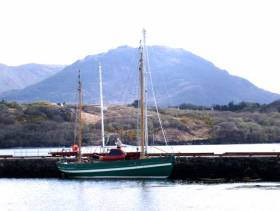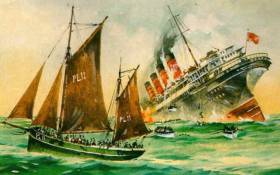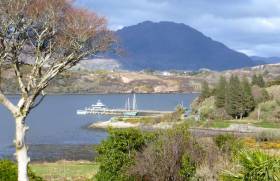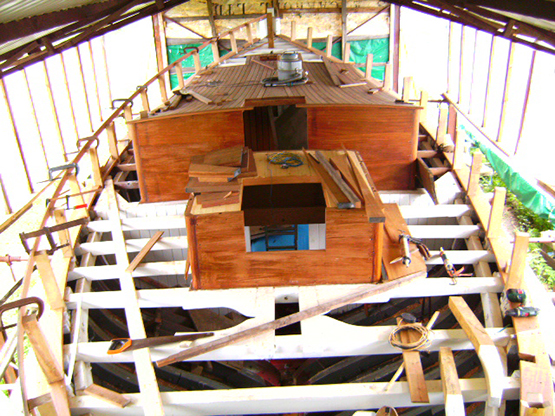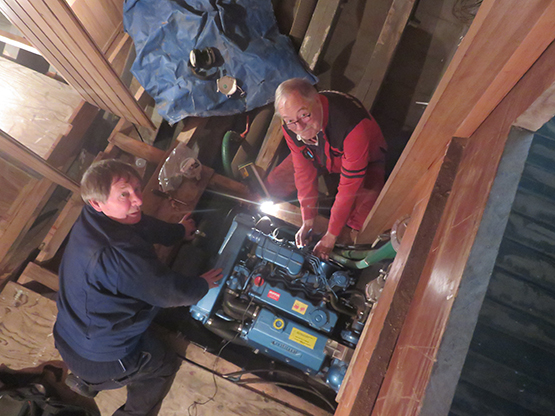Displaying items by tag: Aigh Vie
Lusitania-Linked Historic Ketch Aigh Vie Safe Home to Connemara
The historic 45ft ketch Aigh Vie, built in the Isle of Man in 1916 as an anonymous gift for a fishing skipper who had saved many lives after the sinking of the Transatlantic liner Lusitania in May 1915, is now back in Connemara after a very special voyage which took her back to her birthplace, and ended up becoming a round Ireland cruise as well writes W M Nixon.
The story of the restoration of Aigh Vie in an ocean-side workplace at Renvyle in Connemara has been followed through many postings on Afloat.ie over the years. Multi-talented owner Paddy Murphy - officially he’s a blacksmith, but he can turn his hand to anything - funded the project with a variety of other jobs and continued with the massive task on Aigh Vie (it’s Manx for “good luck” or “fair wind”) when he could find the time, aided now and again by welcome invasions of members of the Dublin Bay Old Gaffers Association, who brought extra skills and much encouragement with them.
Finally, the Aigh Vie was re-launched in April of this year with commissioning being completed at Letterfrack Pier in the natural shelter of Derryinver Harbour. Then Paddy and a crew of two set off to round the south coast of Ireland to join the DBOGA flotilla at Poolbeg in Dublin to go to the Traditional Boat Weekend in Peel in the Isle of Man at the end of July.
 We’re getting there…….Aigh Vie at Poolbeg in Dublin, well on her way from Connemara to the Isle of Man. Photo: W M Nixon
We’re getting there…….Aigh Vie at Poolbeg in Dublin, well on her way from Connemara to the Isle of Man. Photo: W M Nixon
One of the crew’s time ran out, and he’d to leave at Dingle. But Paddy and his grandson Conor pressed on in what was to be the last of the summer’s exceptionally good weather, and arrived into Poolbeg, on time and very welcome. They departed sailing in company for the Isle of Man with extra guest crew, including DBOGA member emeritus Tim Magennis, who’d known Aigh Vie as a fishing boat working from Ardgass in his childhood, and subsequently went on to sail round the world in the Colin Archer ketch Sandefjord, which surely makes him the Old Gaffer’s Old Gaffer.
Despite Tim’s sacred status, the weather was deteriorating, and by the time they’d got safely into Peel Harbour, it was clear that a weekend of seriously foul weather was upon them. But the presence of Aig Vie was something for special celebration among aficionados.
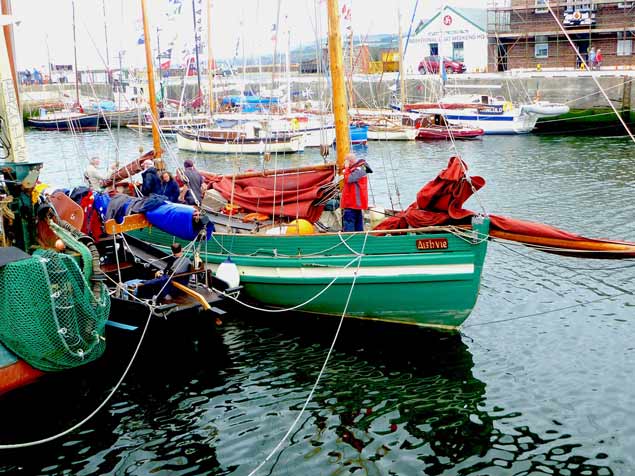 Historic destination achieved. Aigh Vie berthed outside Naomh Cronan in Peel Harbour
Historic destination achieved. Aigh Vie berthed outside Naomh Cronan in Peel Harbour
And as it happened, the enforced harbour stay was a blessing, as Aigh Vie had been living with one of those persistent leaks you can get with traditional wooden boats. But the crew of the Poolbeg-based Galway Hooker Naomh Cronan - which had sailed up to Peel with Aigh Vie - included master shipwright Donal Green of Carna in south Connemara, who served his time with the late great boatbuilder Colm Mulkerrins of Mweenish Island. So it was decided to dry out Aigh Vie at low water, and see about letting Donal fix that leak.
It was some caulking up forward in an awkward location which needed replacing and sealing, but the job was soon done, and after that it was a question of waiting for the weather to settle so that everyone could head for home. While most boats were only bound for ports in the Irish Sea, Aigh Vie’s core crew of Paddy Murphy and grandson Conor wanted to finish the job properly by bring her home to Renvyle round the top.
So as soon as Aigh Vie had got an easing of the weather and with it an aigh vie – a fair wind – she was away like a rocket, sailing like a racing yacht from Peel round the North Coast of Ireland direct to Arranmore off the west coast of Donegal in something like 29 hours or less. Nobody’s too precise on time, the crew of two are only certain that she sailed even better than they expected.
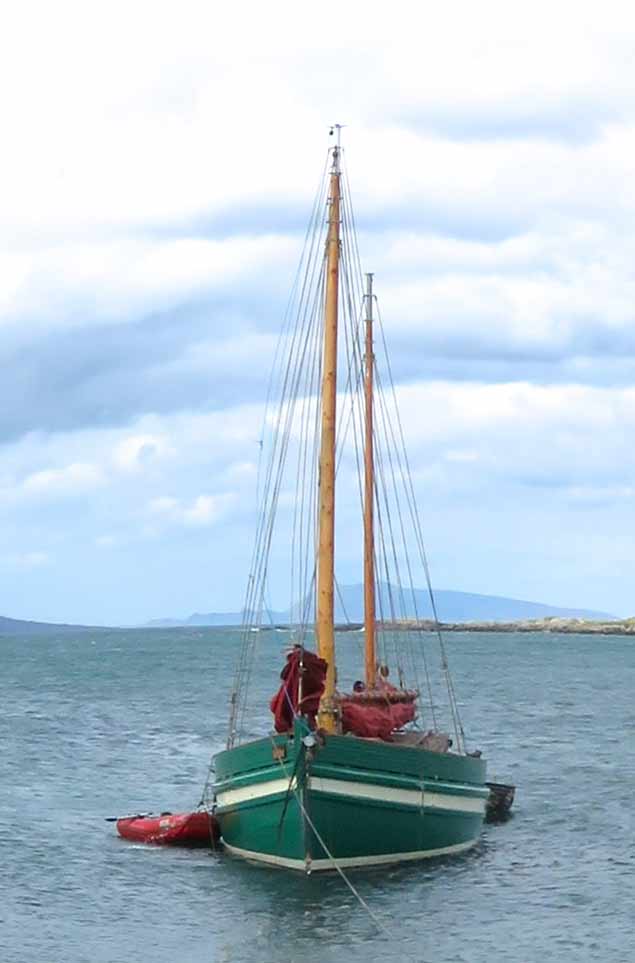 Home again. Aigh Vie on the summer mooring at Renvyle, with the mountains of Achill in the distance. Photo: Cormac Lowth
Home again. Aigh Vie on the summer mooring at Renvyle, with the mountains of Achill in the distance. Photo: Cormac Lowth
From Arranmore on southward, it was a matter of plugging into everything the Atlantic could throw at them, but eventually the mighty cliffs of Achill were put astern and gradually the familiar hills and houses of Renvyle were brought nearer, until finally they were able to secure Aigh Vie to the summer mooring off Paddy’s waterside house.
As Paul Keogh, skipper of the Naomh Cronan, has commented: “The rest of us have been hoping to do a round Ireland cruise for years. These guys end up doing it almost by accident, and at their first attempt too…….”
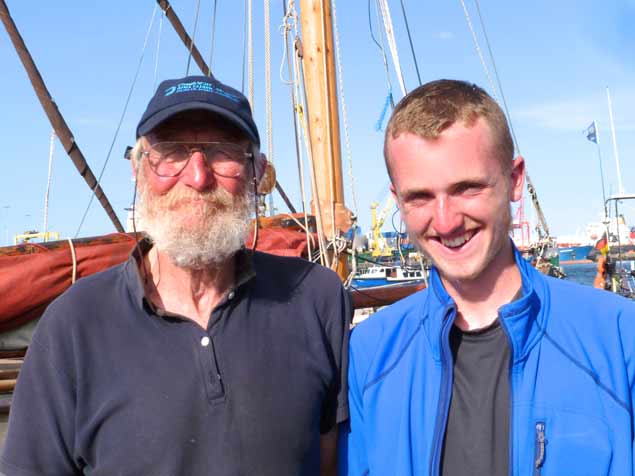 Paddy Murphy and his grandson Conor – they’ve become round Ireland circumnavigators “by accident”. Photo: W M Nixon
Paddy Murphy and his grandson Conor – they’ve become round Ireland circumnavigators “by accident”. Photo: W M Nixon
In the midst of high summer, with life slowed by the all-pervading heat, it is almost impossible to contemplate the sheer horror of total conflict as experienced in the industrialised attacks of the Great War of 1914-18 writes W M Nixon. Yet this week, a jaunty green gaff ketch, attractively fitted with tanned sails, came through Dalkey Sound in style in the sunshine. The Aigh Vie is sailing again. And anyone who knows anything of her history will inevitably find their thoughts tracking back to the sinking by a German submarine’s torpedo of the Transatlantic liner Lusitania – the largest in the world at the time – ten miles south of the Old Head of Kinsale at 2.0pm on May 7th 1915.
The vast liner sank within 18 minutes. The transformation of the scene on board defies imagination. This was luxurious life afloat, with lunch progressing stylishly to its close as the passengers anticipated being in Liverpool early next morning. But barely a quarter of an hour had passed after the torpedo struck before the fatal devastating reality of the ocean – still bitterly cold so early in the summer – was cruelly upon rich and poor alike as the ship sank and those who could took to the lifeboat, while others very quickly found themselves in the sea.
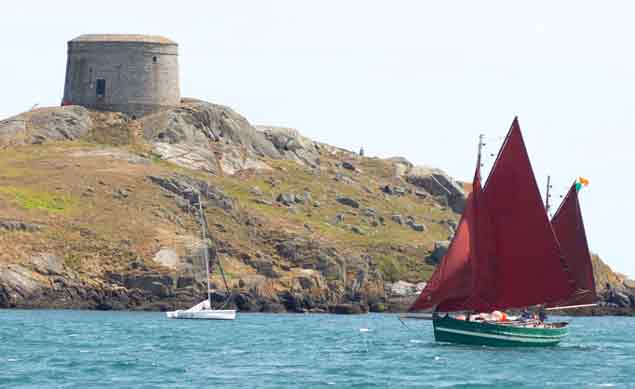 The restored Aigh Vie returns to Dublin Bay for the first time in very many years on Wednesday, sailing in jaunty style through Dalkey Sound. Photo: Gill Mills
The restored Aigh Vie returns to Dublin Bay for the first time in very many years on Wednesday, sailing in jaunty style through Dalkey Sound. Photo: Gill Mills
Although it was a bright afternoon, two hours were to elapse before any sizeable rescuing ship was on the scene, and the only timely aid came from a 22-ton Isle of Man fishing boat, the ketch Wanderer, which had been working within three miles of the attack, and immediately sailed straight towards the scene of devastation even though post-sinking assaults on would-be rescuers were often part of the German U Boats’ modus operandi.
With many hundreds of lives at risk – in all, at least 1,198 lives from a total complement of 1,962 passengers and crew from the Lusitania were to be lost - a vessel of the Wanderer’s size was very limited in what she could do, yet astonishingly she managed to save at least 160 directly. And apart from being filled to the gunwhales with survivors - many of them injured - she was towing crowded lifeboats and heading for port when a substantial steam tug from the Royal Navy bases at Haulbowline and Cobh in Cork Harbour finally arrived and took off the Wanderer’s survivors and casualties as she sailed towards port with her tragic cargo.
With more ships arriving on the scene back out at sea, the Wanderer’s role in the rescue was concluded. But after she had returned to her home port of Peel in the Isle of Man - her crew still traumatised by what they had experienced - it was to find that what they had done without any thoughts for their own safety was to be remembered over the years and particularly in one very tangible way.
Wanderer was owned by a commercial fishing company, and her skipper William Ball was their employee. But his quiet competence and humanity had made a lasting impression on those he had saved, some of whom reputedly were millionaires or their relatives. Before 1915 was over, he had received a letter from a firm of solicitors in Peel informing him that a substantial sum of money had been anonymously lodged to his credit in the town, and it was to be used to have his own fishing boat built in Peel – his dream ship.
 The Wanderer was a fishing ketch of classic late 19th century “Brixham” type...
The Wanderer was a fishing ketch of classic late 19th century “Brixham” type...
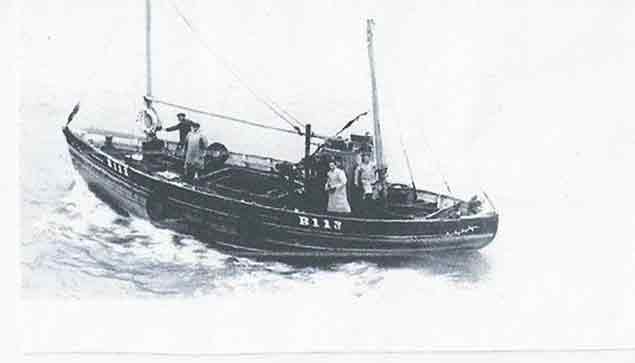 …….but the Aigh Vie of 1916 (seen here in her final fishing years from Ardglass when she was totally engine-driven) was of a much more refined easily-driven shape, and sailed superbly
…….but the Aigh Vie of 1916 (seen here in her final fishing years from Ardglass when she was totally engine-driven) was of a much more refined easily-driven shape, and sailed superbly
The outcome of all this was that William Ball’s 45ft Aigh Vie – it’s Manx for “good luck” – was launched at the end of 1916, and registered as an Isle of Man fishing craft in January 1917. Unlike the Wanderer, which was an orthodox late 19th Century fishing boat of what could broadly be described as the Brixham type, the Aigh Vie was of the developing Manx Nobby form, with such a sweet hull that she was described as “yacht-like”. Yet though she could sail notably well, she always had auxiliary power, as one of the side-effects of wartime’s acceleration of marine technology was that marine engines were becoming more reliable.
Over recent years here on Afloat.ie, we have revealed aspects of Aigh Vie’s subsequent history while her restoration has been in progress at Renvyle in far Connemara by Paddy Murphy, self-funded and working mainly on his own. Originally from Dublin, he and his wife Siobhan settled in Renvyle on the shores of the Atlantic about fifteen years ago, and brought the Aigh Vie with them overland, with Paddy determined that somehow he would continue her restoration until she sailed again.
He describes himself as a blacksmith by trade, but he is a man of very many parts and talents, cheerfully and enthusiastically imbued in Irish music and culture. And in his long ownership of the Aigh Vie, he has found that his project on insufficient resources had become close to hearts of those who knew the vessel from previous stages of her existence.
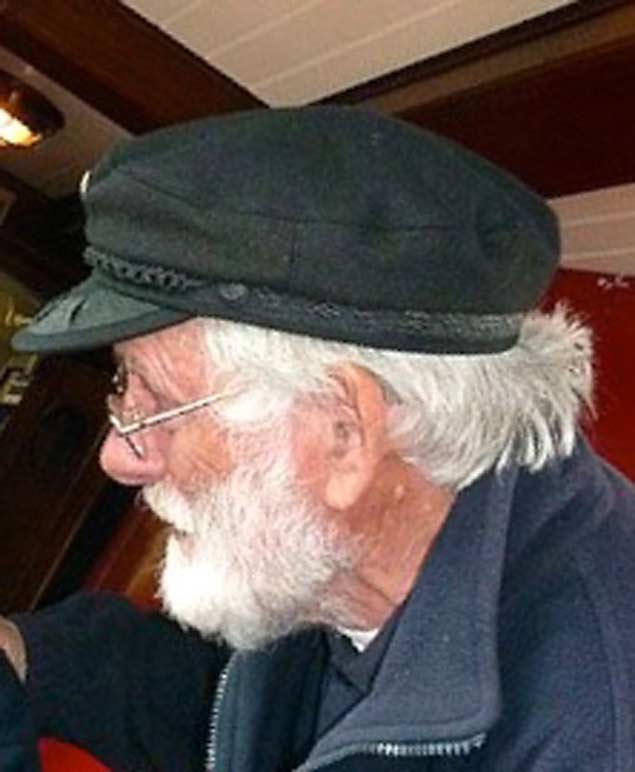 Veteran sailor Tim Magennis – a global voyager under gaff rig – was often aboard Aigh Vie in Ardglass harbour as a boy, and he is aboard for this weekend’s return to her birthplace of Peel. Photo: W M Nixon
Veteran sailor Tim Magennis – a global voyager under gaff rig – was often aboard Aigh Vie in Ardglass harbour as a boy, and he is aboard for this weekend’s return to her birthplace of Peel. Photo: W M Nixon
When she finally finished her days as a Peel fishing boat, she was transferred in the 1930s and ’40s with her near-sisters Vervine Blossom and White Heather to work from Ardglass on the County Down coast, where a very young Tim Magennis and his brothers of a local family were often on board in port.
Tim – subsequently a veteran of a round the world voyage in a Colin Archer gaff ketch, and more recently President of the Dublin Bay Old Gaffers Association – well remembers that he and his brothers were allowed on board Aigh Vie when she returned to port provided they took on the task of clearing the scuppers of prawns, which were regarded as a non-commercial nuisance in those days, despite some of them being of substantial size. Fortunately, his mother appreciated their exceptional food quality, and the Magennis family often feasted in style on what was regarded as waste, yet became in time one of County Down’s most lucrative catches.
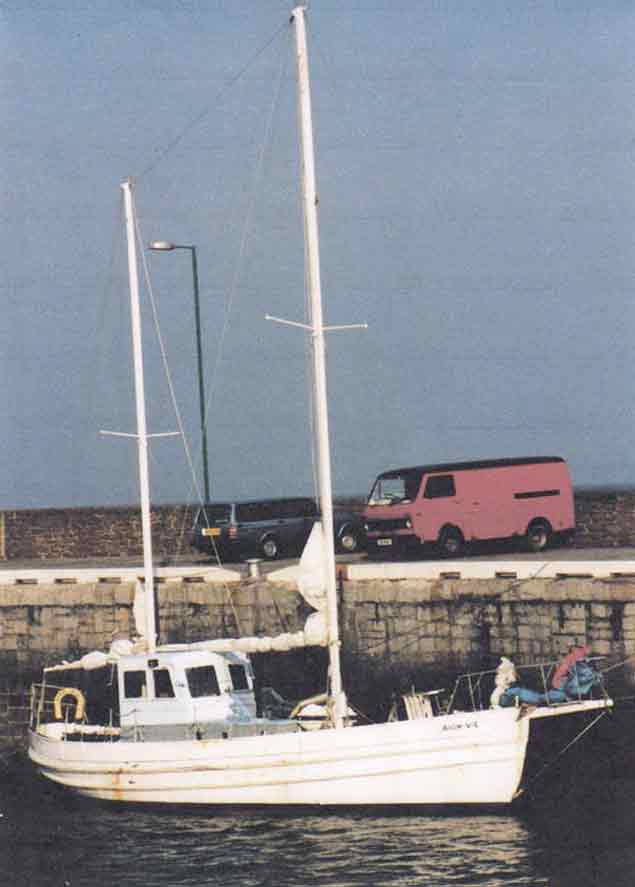 Aigh Vie as she became under the ownership of Billy Smyth of Whiterock in Strangford Lough, and used extensively for cruising the West Coast of Scotland
Aigh Vie as she became under the ownership of Billy Smyth of Whiterock in Strangford Lough, and used extensively for cruising the West Coast of Scotland
By the end of her fishing days, Aigh Vie was completely engine-powered. But boatyard-owner Billy Smyth of Whiterock in nearby Strangford Lough fully appreciated her sweet sailing hull. Converted to a cruising yacht, Aigh Vie was soon setting a Bermudan ketch rig while continuing with a more-than-adequate engine. Comfortable accommodation was installed, with a wheelhouse which took full account of the Irish and Scottish weather, and for many years each summer the Smyth family cruised the Hebrides and the West Coast of Scotland and northward to the Orkneys with such lasting effect that Billy Smyth’s son, master boatbuilder Maurice Smyth, has from time to time turned up in Renvyle to help Paddy with his enormous task of restoration.
Regular readers of Afloat.ie will be well aware of the details of this lengthy project, which has taken either 15 years or 21 years, depending on whether you start counting from the time Paddy Murphy bought the by-now ageing Aigh Vie from Billy Smyth and sailed her home to Dublin with a crew including Tim Magennis, or whether you begin from the time that Paddy decided city life was not for him and moved to the big country of the west.
 All the sweetness of Aigh Vie’s lines was revealed at this early stage of the restoration in Renvyle Photo: W M Nixon
All the sweetness of Aigh Vie’s lines was revealed at this early stage of the restoration in Renvyle Photo: W M Nixon
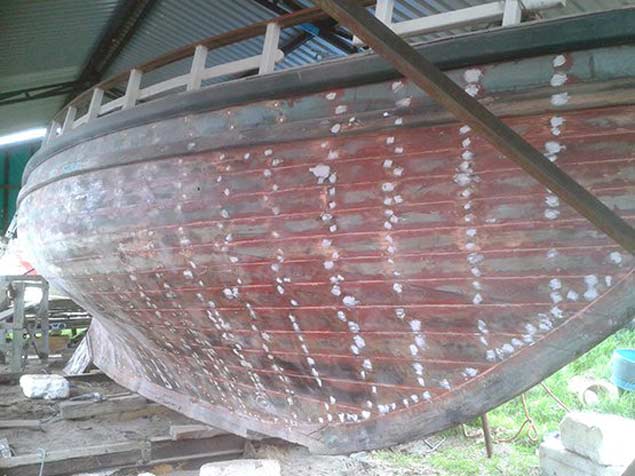 It was found that restoring the lower planking was made more accessible by heeling the boat over. Photo: W M Nixon
It was found that restoring the lower planking was made more accessible by heeling the boat over. Photo: W M Nixon
Either way, the continuing saga of the restoration of Aigh Vie has become part of the Irish sailing scene for a long time, with flurries of extra activity every so often when work parties from the Dublin Bay Old Gaffers Association would descend on Renvyle to help the project on its way. And it all moved on to a new stage this year in April when Aigh Vie was finally launched down the shingle beach at Renvyle and moved round to the shelter of Derryinver Harbour for commissioning to be completed.
 At last…..Aigh Vie launches down the beach at Renvyle, April 2018. Photos: Cormac Lowth
At last…..Aigh Vie launches down the beach at Renvyle, April 2018. Photos: Cormac Lowth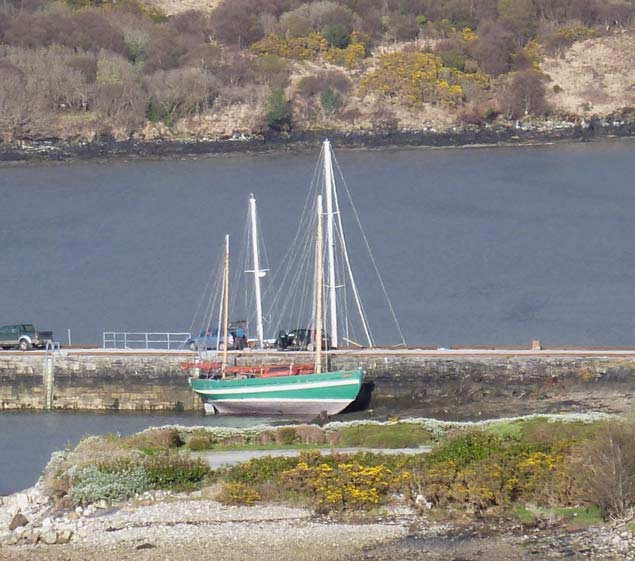 Aigh Vie’s commissioning berth after launching was Lettterfrack Pier deep in the northern heart of Connemara. Photo: W M Nixon
Aigh Vie’s commissioning berth after launching was Lettterfrack Pier deep in the northern heart of Connemara. Photo: W M Nixon
In April, we were all looking pale and exhausted after the longest, coldest and wettest winter in memory, and Paddy Murphy was no exception. But when I met him this week at Poolbeg Y & BC marina in Dublin on Wednesday after he and his grandson Conor had completed the voyage round from Derryinver, he was a man transformed, glowing with health and enthusiasm, and keen to continue with the project of sailing Aigh Vie the rest of the way to her birthplace of Peel in time for this weekend’s Traditional Boat Weekend at that characterful little harbour, where a useful water-retaining flapgate on the dock entrance makes the former home port of Wanderer and Aigh Vie an extremely effective facility in an area of large tides.
 Paddy Murphy in April, with much work still to do. Photo W M Nixon
Paddy Murphy in April, with much work still to do. Photo W M Nixon
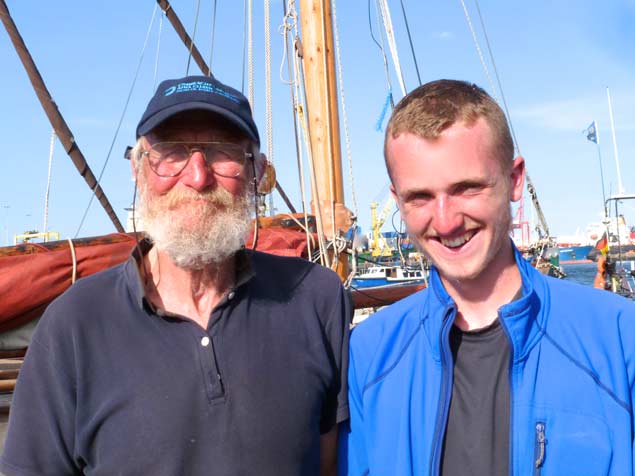 A man transformed. Paddy Murphy was glowing with health at Poolbeg on Thursday after he and his grandson Conor (right) had brought Aigh Vie round the south of Ireland from Connemara. Photo: W M Nixon
A man transformed. Paddy Murphy was glowing with health at Poolbeg on Thursday after he and his grandson Conor (right) had brought Aigh Vie round the south of Ireland from Connemara. Photo: W M Nixon
When Aigh Vie arrived in Dublin Bay on Wednesday, she was met by Paul Keogh and his shipmates on the Clondalkin-built Galway Hooker Naomh Cronan, and escorted into port with the hooker in the lead until Paul suggested Aigh Vie go ahead, as an easily-accessed walkway berth at Poolbeg had been cleared and retained for her.
So Paddy Murphy upped the throttle, and it was a revelation. Aigh Vie has been fitted with a 110hp Nanni Kubota diesel, and soon she had a bone in her teeth, sweeping past Naomh Cronan at a speed which can apparently be pushed up to 9 knots, yet leaving little wake behind her. That elegant stern which William Ball specified from designer-builders Nicolson & Watson in Peel is a miracle of good design - a more brutal shape would pull half the ocean astern of her.
 Even with the pontoon obscuring the full view, Aigh Vie at Poolbeg shows her classic elegance. Photo: W M Nixon
Even with the pontoon obscuring the full view, Aigh Vie at Poolbeg shows her classic elegance. Photo: W M Nixon
 Berthed at Poolbeg, the haul shapes of the classic Galway hooker Naomh Cronan (left) and the Aigh Vie make for an intriguing comparison. Photo: W M Nixon
Berthed at Poolbeg, the haul shapes of the classic Galway hooker Naomh Cronan (left) and the Aigh Vie make for an intriguing comparison. Photo: W M Nixon
But Aigh Vie is emphatically not of brutal shape. She is all of a piece, with a jaunty sheer which warms the heart, while Paddy has fitted her with a compact and easily-handled yet effective gaff ketch rig to provide all passage-making options.
There is still much work to be done. But the fact that she came all the way around from Connemara with just two stops – in Dingle and Crosshaven – shows just how much has been done, and on Thursday night in company with Naomh Cronan and other Dublin Bay traditional and classic craft, she made the passage from Poolbeg to Peel with her crew including Paddy’s wife Siobhan, the one and only Tim Magennis himself, Irish survey ship captain Sean Cullen whose father sailed around the world with Tim on the Sandefjord so many years ago, and Gill Mills.
Finally today in Peel, amidst so many like-minded souls and spirits at the Traditional Boat Weekend, the story will come full circle 103 years after the Lusitania horror, and 101 years after the wonderful Aigh Vie was first commissioned.
 With the Isle of Man’s exceptionally high tides, a flap gate in the entrance which retains the water in Peel Harbour, yet permits access 2 hours either side of high water, has made this one of the Island’s most popular cruising destinations, and an ideal setting for the Traditional Boat Weekend. Photo: W M Nixon
With the Isle of Man’s exceptionally high tides, a flap gate in the entrance which retains the water in Peel Harbour, yet permits access 2 hours either side of high water, has made this one of the Island’s most popular cruising destinations, and an ideal setting for the Traditional Boat Weekend. Photo: W M Nixon
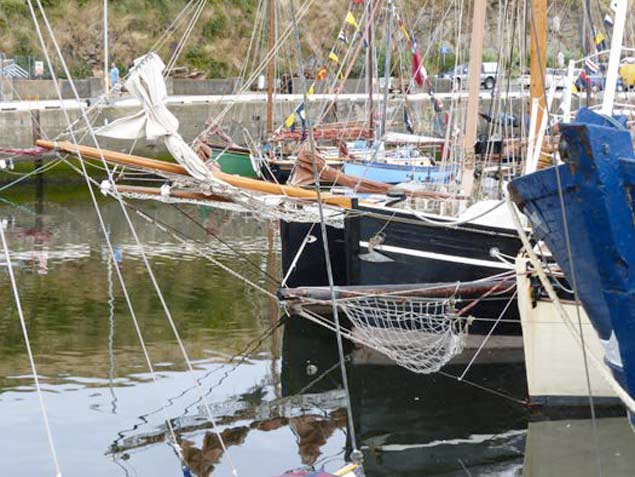 Enough variety in ancient bowsprits to satisfy even the most dedicated enthusiast…..the selection of boats which gather in Peel for the Traditional Boat Weekend is fascinating. Photo: W M Nixon
Enough variety in ancient bowsprits to satisfy even the most dedicated enthusiast…..the selection of boats which gather in Peel for the Traditional Boat Weekend is fascinating. Photo: W M Nixon Paddy Murphy of Renvyle calls himself a blacksmith, but there’s much more to him than that…..Photo: W M Nixon
Paddy Murphy of Renvyle calls himself a blacksmith, but there’s much more to him than that…..Photo: W M Nixon
The wind is at last from the west, the easterlies of the longest winter in memory have finally relented, and it’s time to be in the west of Ireland and Connemara, time to eavesdrop on two senior boat restorers as they yarn about the challenges they face, and where it might all go writes W M Nixon.
Dickie Gomes of Strangford Lough has been custodian and skipper of the 36ft–Ainmara for more than fifty years. She was designed and built by John B Kearney in Ringsend in Dublin in 1912. The other boat custodian is Paddy Murphy, who once upon a time was Ringsend-based, but he now lives in far Renvyle in northwest Connemara. For many years he has been grappling – both in Dublin and in Connemara - with the challenge of bringing the 1916-built 45ft Isle of Man fishing boat Aigh Vie back to life.
 Even when she was first built in 1916, it was said that Aigh Vie looked more like a yacht than a fishing boat. Photo: W M Nixon
Even when she was first built in 1916, it was said that Aigh Vie looked more like a yacht than a fishing boat. Photo: W M Nixon
Both boats have more stories entwined about them than you’d think possible. John Kearney was a foreman shipwright in Dublin Port, but he wanted to be a yacht designer. And he is so described on his gravestone in Glasnevin in Dublin, his wish fulfilled when he died aged 88.
"John Kearney was a foreman shipwright in Dublin Port, but he wanted to be a yacht designer"
He was one tough little man. So determined was he to design and build Ainmara to prove himself that, after he’d finished his hard day in the Dublin Port workshops, he would return home across the Liffey to Ringsend by the little local ferry, and then set to work every night, building Ainmara without any power tools, with his tasks illuminated by oil lamps. He had the job finished in 18 months.
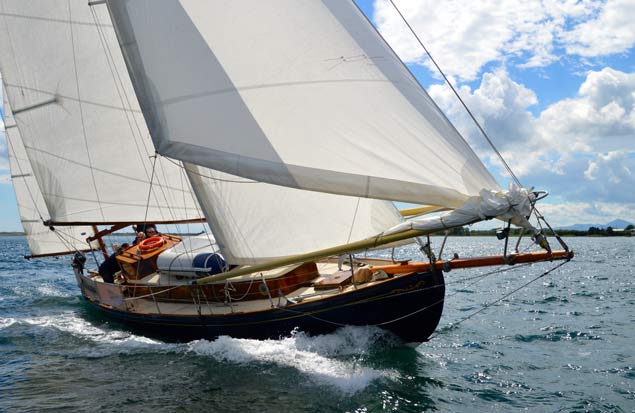 Ainmara in her home waters of Strangford Lough, a 1912-built vessel restored by Dckie Gomes. Photo: Pete Adams
Ainmara in her home waters of Strangford Lough, a 1912-built vessel restored by Dckie Gomes. Photo: Pete Adams
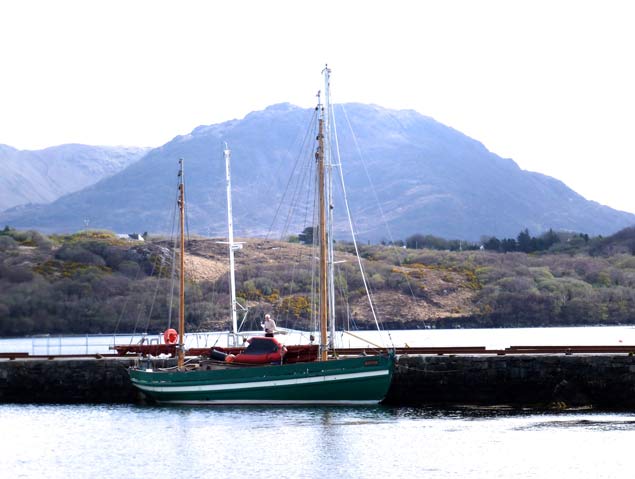 At Letterfrack Pier, Aigh Vie floats to her marks on the morning tide. Photo: W M Nixon
At Letterfrack Pier, Aigh Vie floats to her marks on the morning tide. Photo: W M Nixon
 In the first of the late Spring sunshine, the new spirit blossoms. Photo: W M Nixon
In the first of the late Spring sunshine, the new spirit blossoms. Photo: W M Nixon
Aigh Vie, as we’ve recounted here in Afloat.ie, was the result of an anonymous gift to the captain of an Isle of Man sailing trawler which was owned by others. That trawler – the Wanderer - was the first vessel to reach the stricken ocean liner Lusitania after she’d been hit by torpedoes from a German submarine off the Old Head of Kinsale during the Great War in 1915.
The trawler captain William Ball and his crew were heroic in saving something like 160 lives. And within a year, this mysterious sum of money appeared with a firm of solicitors in his home port of Peel, with the request that Captain Ball commission the local boat-building company to construct his own dreamship. The Aigh Vie was the result.
 The brotherhood. Dickie Gomes of Ainmara and Paddy Murphy of Aigh Vie. Photo: W M Nixon
The brotherhood. Dickie Gomes of Ainmara and Paddy Murphy of Aigh Vie. Photo: W M Nixon
Thanks to the uniquely informative Cormac Lowth, we knew that Paddy Murphy’s recently-launched vessel was berthed at a quay on Ballynakill Harbour. Nevertheless it was one of those moments of purest serendipity when we settled into our place for the weekend while still in the distinctly crisp weather of late April, and there right below the window was Aigh Vie, at Letterfrack Pier glowing in the evening sunlight.
Next day, the two great men, Dickie Gomes and Paddy Murphy, got together without any pre-arrangement. It was something special being in their company. It was five years since last they met, at a time when the Aigh Vie project was still at an early stage. But they’re so precisely on the same wavelength that there was no need for re-introductions - empathy was always present.
 There is still much work to be done in Aigh Vie’s accommodation, but the basic layout is shaping up very well. Photo: W M Nixon
There is still much work to be done in Aigh Vie’s accommodation, but the basic layout is shaping up very well. Photo: W M Nixon
Paddy still has much to do, but it was inspirational nevertheless. He has his own way of doing things, yet beneath all the signs of Work in Progress, there was much evidence that a very attractive layout is developing below, while on deck the concept speaks for itself.
"It is a drumbeat which only a few can hear clearly enough to follow, but those that do sometimes follow it for very many years"
But to understand it all, to grasp the deeper meaning of why people take old boats and work all hours to breathe new life into them, you have to be of a strange brotherhood, a brotherhood which walks and sails to the beat of a different drum. It is a drumbeat which only a few can hear clearly enough to follow, but those that do sometimes follow it for very many years.
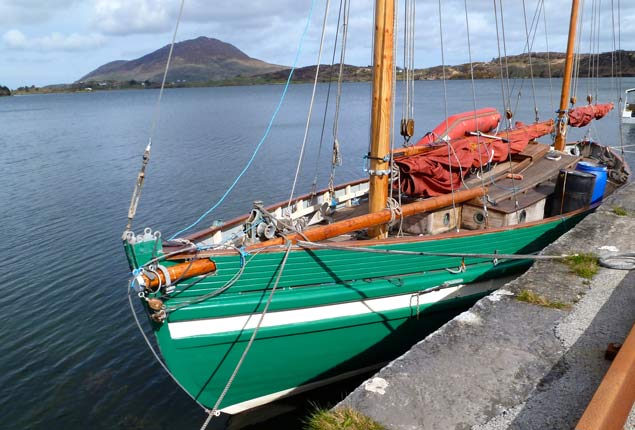 In her new form, Aigh Vie is a handsome vessel. Photo: W M Nixon
In her new form, Aigh Vie is a handsome vessel. Photo: W M Nixon
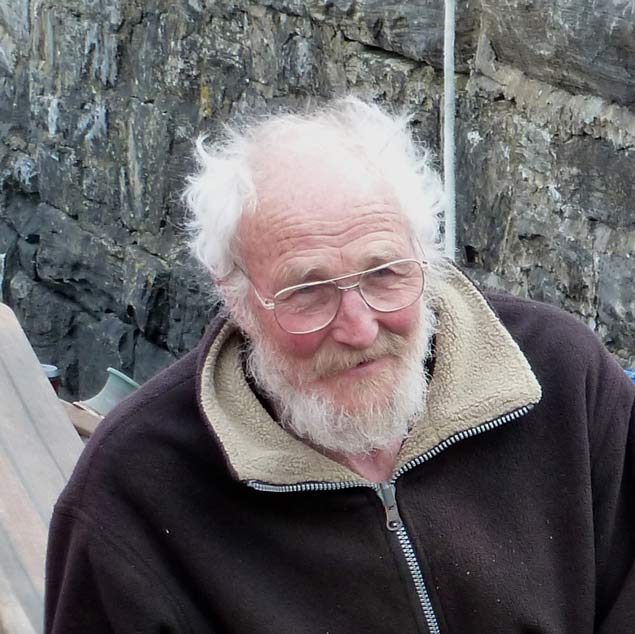 Paddy Murphy of Renvyle, man of many talents. Photo: W M Nixon
Paddy Murphy of Renvyle, man of many talents. Photo: W M Nixon
Christmas Dreams Of Irish Wooden Boats – Old & New, Real & Fantasy
The season is upon us for goodwill and dreams of very special gifts. And for many Irish sailors, the dream Christmas present would be an elegantly classic or solidly traditional wooden boat, with all maintenance and running costs somehow covered by Divine Providence into infinity……W M Nixon goes down the Yuletide timber trail.
Love of wood is part of what we are. It’s in our genes. At some times and some places in the remote past, an instinctive fondness for wood, and an inherited ability to do something useful with it, would make all the difference between survival and extinction. So though today the availability of other more purposeful materials may have transformed boat-building, a new boat without some sort of wood trim is a very rare thing indeed.
At a more personal level, many of today’s generation of sailors cherish family memories of the communal building of wooden DIY kit boats at home. Here, there and everywhere, a drawing room or little-used dining room found itself a useful new purpose as a boat-building salon, with Mirror dinghies and occasionally larger craft taking shape in domestic settings throughout the land.
“Our daddy the boat-builder” became a household name in his own household. And for those who sometimes wonder why today’s adult sailors can become misty-eyed at the very thought of the Mirror dinghy (which really was and is a wonderful design and concept), the answer surely is that at a significant stage of their sailing and family life, a Mirror dinghy was centre stage, the symbol of a family’s shared values, hopes and interests.
But maybe the most important thing about the Mirror is that she is so eminently practical. So perhaps at Christmas we should allow our imaginations to take flight and soar high to envisage the complete wooden dreamship. And there she is as our header image, introducing this week’s meandering thoughts. That schooner at the moment is total fantasy. But any sailing enthusiast who looks at that concept design and doesn’t think: “Now there’s my dreamship”, well, he or she just doesn’t have a true sailing soul.
The origins of Eirinn, as she is named for the time being, go back to 2012, when the nascent Atlantic Youth Trust sought suggestions as to what a new sail training vessel for all Ireland should look like. But with their proposals recently getting the first real hints of a fair wind from both governments, the AYT have gone firmly down the route of a 40 metre steel barquentine.

The Ilen as she was in the Spring of 2015 in Oldcourt...
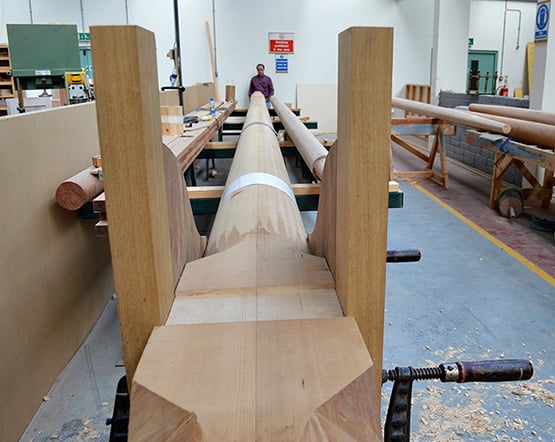 ….while in the Ilen Boatbuilding School in Limerick, spars and deckhouses were taking shape
….while in the Ilen Boatbuilding School in Limerick, spars and deckhouses were taking shape
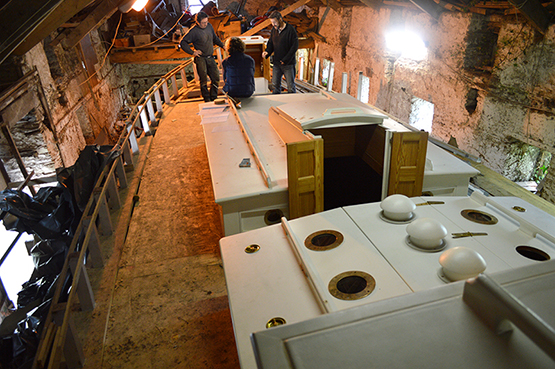
Deckhouses built in Limerick are offered up on the Ilen in Oldcourt
However, down in Limerick where they were busy with moving forward the restoration of the Conor O’Brien 1926 ketch Ilen at two sites – the hull with Liam Hegarty in Oldcourt near Baltimore in West Cork, and the deckhouses, spars and other smaller items being built at the Ilen Boat Building School in Limerick – they gave some thought in 2012 to the possible form of a new sail training vessel. They came up with the concept of a classic 70ft schooner which they knew, thanks to the work on Ilen, that they could build themselves using the skills learned and deployed in re-building the O’Brien ketch.
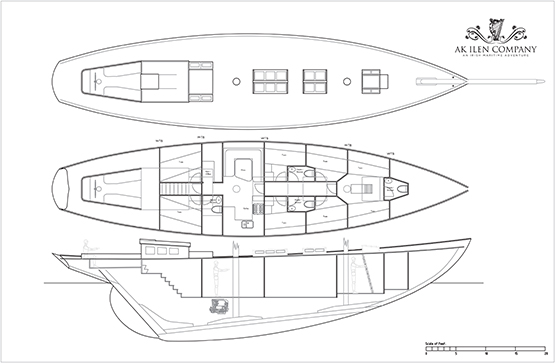
A classic hull for a classic schooner – Theo Rye’s profile and general arrangements plan for the schooner concept of 2012
But with the Ilen project moving steadily on towards the vessel’s commissioning next summer, and with other directly-related new proposals at an advanced stage in the pipeline, that sublime schooner concept is in a sort of limbo, truly a fantasy.
Yet she’s such a lovely thing that we’re happy to use her as our symbol of Christmas cheer. Her creators are Gary MacMahon of the Ilen Boatbuilding School, and Theo Rye, who is best known as a technical consultant in naval architecture, and on clarifying matters of design history and detail in boat and yacht design. But he can turn his hand to all sorts of design commissions if required. He came up with the clever concept for the CityOne dinghies in Limerick, and when Gary started musing about a classic training schooner, within the scope of what the Ilen school could do, as their answer to the AYT sail training vessel query, Theo came up with the goods and then some.
In fact, the design of the hull is so perfect that we’ll run it again right here to save you the trouble of scrolling back to the top. The overhangs at bow and stern are in harmony, but it is the sheerline which is the master-stroke. There isn’t anything you’d want to change in it, yet when you look at other famous schooners such as the fictional Southseaman (in real life she was Northern Light) in Weston Martyr’s masterpiece of maritime literature The Southseaman – the Story of a Schooner (1926), we see a sheerline which is too flat in the way of the foremast. But with Eirinn, the curve is just right, and it’s something achieved by tiny adjustments and balances which the eye can’t really perceive, yet somehow it registers the sublime harmony of the total concept.
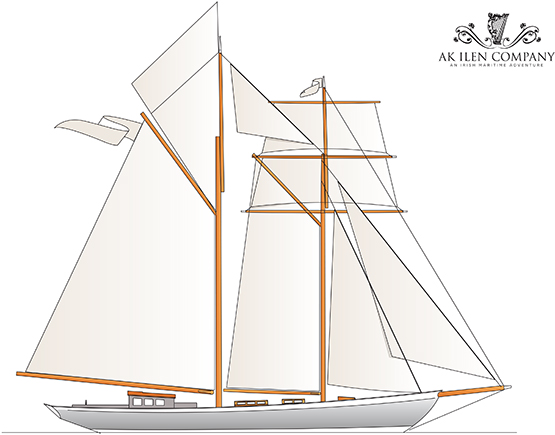
Worth a second look – and then a third one. The longer you look at the lines of Eirinn, the sweeter they seem. But her overall appearance might be improved with a slight rake of the masts
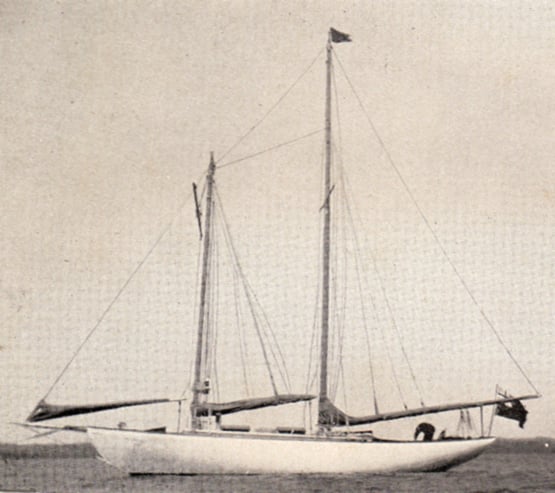 A schooner sheer not quite right – Weston Martyr’s Southseaman (aka Northern Light) could have done with a livelier sheerline abeam of the foremast.
A schooner sheer not quite right – Weston Martyr’s Southseaman (aka Northern Light) could have done with a livelier sheerline abeam of the foremast.
So Theo Rye not only writes critiques of other people’s designs, but if given the chance he can personally come up with something which is wellnigh impossible to fault. Of course, we mightn’t quite go for the same rig – a little bit of rake in the masts wouldn’t go amiss - and for private use you’d want something a little different from the dormitory layout of the training ship. But that said, this is a beautiful yet not excessively pretty-pretty hull, a boat which sings. And the fact that she’s beyond just about every private owner’s reach only adds to the mystique.
But to redress the balance, last week we’d an inspiring evening’s entertainment and information about a dreamship which really is being re-created. It was the December gathering of the Dublin Bay Old Gaffers Association in the ever-hospitable Poolbeg Y & BC, and a full house was there to hear about how Paddy Murphy of Renvyle in the far northwest of Connemara is getting on with his mission of bringing the famous Manx sailing nobby Aigh Vie back to life.
Paddy himself is something special. When asked his trade, he says he’s a blacksmith. But he can turn his hand to anything. Originally a Dub, his early sailing experiences included owning a Flying Fifteen and a Dragon, though not – so far as I know – at the same time. But then got the gaff rig traditional boat bug, and a sail on Mick Hunt’s Manx nobby Vervine Blossom sent him in pursuit of near-sister Aigh Vie. She was reportedly for sale, having for a long time been the pet family cruising boat of Billy Smyth and his family at Whiterock Boatyard on Strangford Lough, after spending her final working years fishing as a motorized vessel out of Ardglass.

Aigh Vie as she was in Whiterock Boatyard when Paddy Murphy bought her, her elegant huul shape clearly in evidence
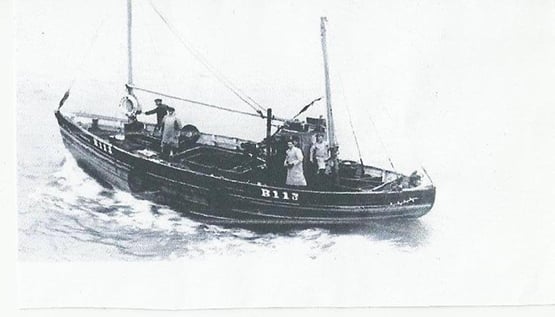 Aigh Vie in her final working days as a motorised fishing boat based at Ardglass
Aigh Vie in her final working days as a motorised fishing boat based at Ardglass
The deal was done, an ideal buy for a special man like Paddy Murphy, for the Aigh Vie is one very special vessel. The Manx fishing nobbies reached their ultimate state of development in the first twenty years of the 20th Century before steam power and then diesel engines took over. The nobby evolved to an almost yacht-like form through vessels like the 43ft White Heather (1904), which is owned and sailed under original-style dipping lug rig by Mike Clark in the Isle of Man, and the 1910 Vervine Blossom, now based in Kinvara, which was restored by Mick Hunt of Howth, but he gave her a more easily-handled gaff ketch rig which looked very well indeed when she sailed in the Vigo to Dublin Tall Ships Race in 1998.
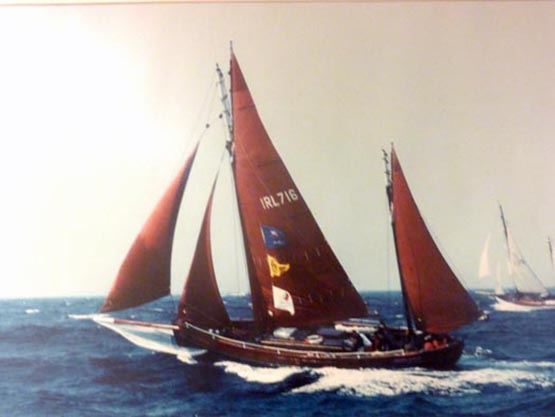
It was a sail on Mick Hunt’s 1910-built Manx nobby Vervine Blossom which inspired Paddy Murphy to go in pursuit of Aigh Vie
It takes quite something to outdo the provenance of these two fine vessels, but the story of Aigh Vie (it means a sort of mix of “good luck” and “fair winds” in Manx) is astonishing. It goes back to the sinking of the Lusitania by a German U Boat off the Cork coast in May 1915, when the first boat to mount a rescue was the Manx fishing ketch Wanderer from Peel, her crew of seven skippered by the 58-year-old William Ball.
They came upon a scene of developing carnage. Yet somehow, the little Wanderer managed to haul aboard and find space for 160 survivors, and provide them with succour and shelter as they made for port. In due course, as the enormity of the incident became clear, the achievement of the Wanderer’s crew was to be recognised with a special medal presentation. And then William Ball, who had been an employee of the Wanderer’s owner, received word that funds had been lodged with a lawyer in Peel on behalf of one of the American survivors he’d rescued. The money was to be used to underwrite the building of his own fishing boat, to be built in Peel to his personal specifications. The name of the donor has never been revealed, but the result was William Ball’s dreamship, the Aigh Vie, launched in December 1916 and first registered for fishing in January 1917.
Over the years, the Aigh Vie became a much-loved feature of the Irish Sea fishing fleet. Tim Magennis, former President of the Dublin Bay Old Gaffers Association, well remembers her from his boyhood days in the fishing port of Ardglass on the County Down coast. Her working days over, Billy Smyth gradually converted her to a Bermudan-rigged cruising ketch with a sheltering wheelhouse which enabled the Smyth family to make some notable cruises whatever the weather. His son Kenny Smyth, who now runs the boatyard with his brothers and is himself an ace helm in the local 29ft River Class, recalls that the seafaring Smyth family thought nothing of taking the Aigh Vie to the Orkneys at a time when the average Strangford Lough cruiser thought Tobermory the limit of reasonable ambitions.
After he’d bought the Aigh Vie and brought to her first base in Howth, Paddy Murphy soon realised he’d still a lot to learn about sailing and about keeping hard-worked old wooden boats in seafaring condition. But he’s such an entertaining and inspirational speaker that you’re swept along in his enthusiasm and empathise with his admission that, now and again, he felt things were getting on top of him.
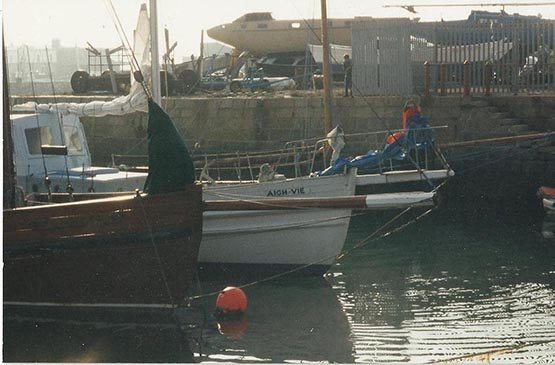
Sisters - Vervine Blossom (foreground) and Aigh Vie in Howth
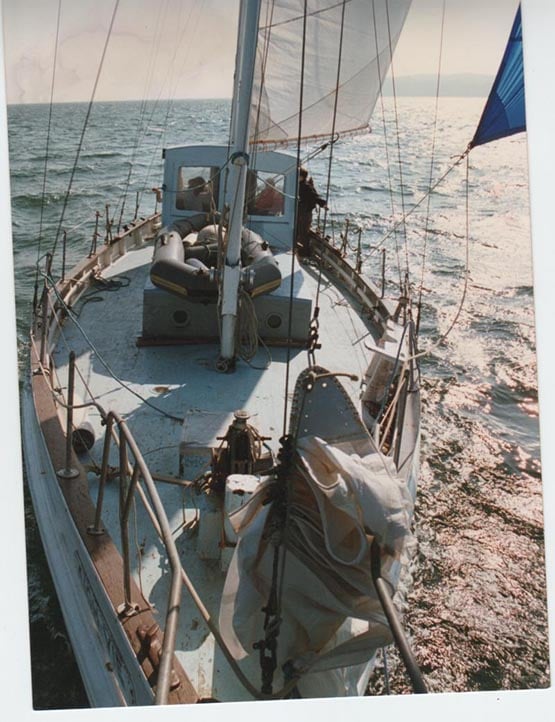
Sailing days on the Aigh Vie from Howth, before it was decided that she needed a major restoration
Following several seasons with increasing evidence of problems, he decided that a virtual re-build was necessary. It was then that the Dublin wooden boat owners’ perennial problem shot to the top of the agenda. In our very expensive city, the space and shelter to work long hours at an old wooden boats is almost impossible to come by, and he’d to shift the big Aigh Vie several times. On one occasion, he was asked to move in a hurry out of an ESB shed, but was offered £1,000 (this was pre-Euro days) to do so. He moved heaven and earth and finally found somewhere else at considerable expense, got the Aigh Vie installed there, and then went back to collect his thousand snots. Only to be laughed at. The manager told him it was the only way he could see to get the old boat moved out, but there were absolutely no funds available at all for such a thing, and surely Paddy would have guessed that?
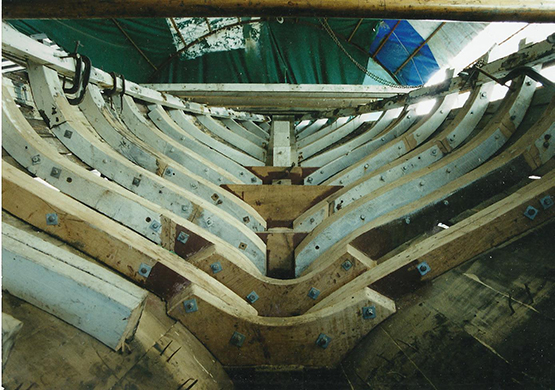
The re-building under way at Renvyle, using the technique where hull shape is retained by first replacing every other frame
With one thing and another, he moved to Renvyle in Connemara where he liked the big country and the open spaces and the friendly people right on the edge of the Atlantic, and in time Aigh Vie came too, and found herself being slowly re-born under a special roof. But it was demanding work for one man, so every so often a team led by Paul Keogh of the famous Galway Hooker from Clondalkin, the Naomh Cronan, together with a good selection of DBOGA specialist talent, descends on Renvyle to put in a ferocious day or two of work, and then on the Saturday night they put a fair bit of business the way of the pub at Tullycross.
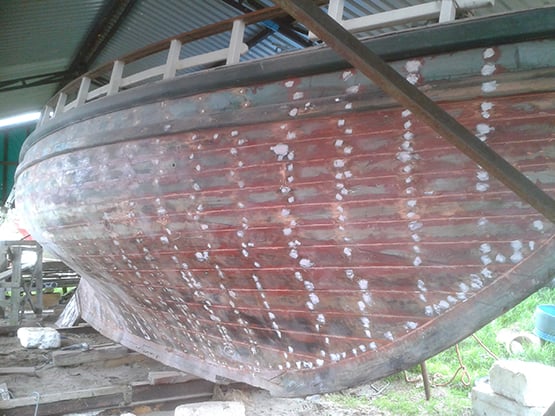
The planking was more easily restored by laying the Aigh Vie over on her side
Agh Vie upright again, and the deckhouses are being put in place
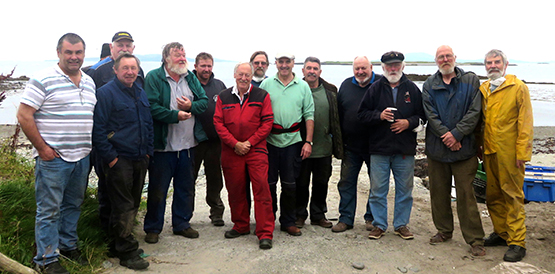
Old Gaffers Association International President Sean Walsh (right) and Peter Redmond install Aigh Vie’s new Perkins diesel. Photo: Cormac Lowth

One of the options for Aig Vie’s rig is the classic lug ketch as shown here with Mike Clark’s 1903-built White Heather
So now, many years later, the journey towards the restored Aigh Vie is getting near its destination. But it will never be fully ended. Thanks to sails, spars and rigs donated from other boats, Paddy has the choice of either gaff ketch or classic lug rig, so she’ll always be work in progress. Which is good news. Because every couple of years or so, the DBOGA can guarantee a full house to hear Paddy Murphy talking about how the Aigh Vie story is going.
He’s a wonderful speaker, sometimes almost messianic, and he shares his every feeling. Thus he mentioned that one day he was feeling a bit low, and he just went out to look at the big boat down by the shore, seeking some sort of inspiration. His mind had been elsewhere with the details of completing the interior, but he suddenly realised that he was at the stage of thinking of putting the white paint on the topsides. So he just set to with a big paint brush and a bigger tin of paint, and Aigh Vie was transformed. So was he. “That’s the secret” says he. “If you’re feeling a bit down, just go out and slap on some white paint. It works wonders.”

Feeling a bit down? Then just go out and slap a coat of white paint on the boat – it works wonders
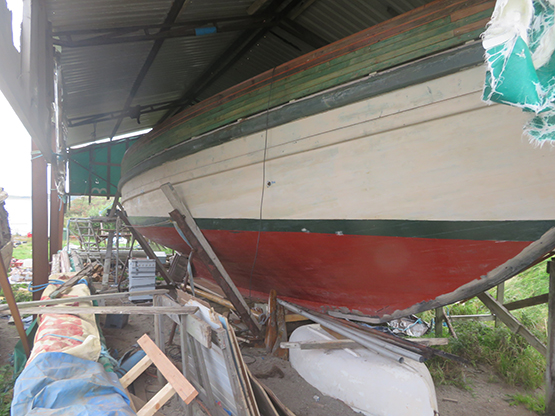
Ireland's West Coast – Special Boats & Big Hearted Sailors
#historicboats – These days we're told of the growing disparity between the economic recovery of Ireland's eastern region, and the relative economic stagnation of some of the rest of the country. But W M Nixon suggests that, for one part of the western seaboard at least, there's a special vitality to life around boats which challenges this perception, and could usefully be emulated elsewhere. And he signs off with a thought-provoking conclusion.
Connemara, Conamara. Spell it as you wish, but The Land of the Sea on Connacht's most westerly coast fires the imagination and inspires the spirit. It's a place of the mind as much as a place of wild mountains where rocky inlets wind their way deep into rugged country. So while purists might define it exclusively as the much intertwined coastline with its myriad islands between Spiddal and Killary, many of the rest of us can be so inspired by that special Connemara quality that we reckon it runs all the way from Galway Bay to Achill. And anyone from that magic coastline, or indeed anyone who has been inspired by it, carries the spirit of Connemara with them wherever they may be.
The boat people you meet out there, each with their own unique and often ambitious maritime agenda, will send you on your way re-enthused about boats and places and their many possibilities. And when someone from another place or indeed another country decides that it's in Connemara their true self and fulfilment is to be found, far from being seen as exiles they are instead seen as a new focal points for their old groups, and their soul-mates from times past descend on them in Connemara for inspiration and mental re-birth.
This weekend, the boat men from Clondalkin in outer Dublin are journeying to Renvyle on the furthest far west coast to help one of their own in his boat restoration programme at a storm-battered corner on a bit of coast which was almost washed away in the winter's seemingly endless climatic violence.
The men of Clondalkin are the community group who built and sail and continue to lovingly maintain the large Galway Hooker Naomh Cronan. Recently, they've been busy enough with replacing some planks on their hefty big boat. But their key organiser Paul Keogh is mindful of the fact that one of their own, Paddy Murphy, is in the west, living on an Atlantic point out beyond the old Oliver St John Gogarty house which is now the hotel at Renvyle.
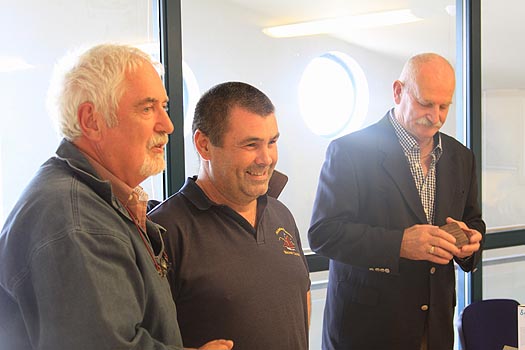
They dreamed the dream, and they made it happen. Key movers in the Naomh Cronan story were Stiophan O Laoire (left) and Paul Keogh, seen here at Poolbeg Y & BC as they come forward to accept a prize on behalf of the crew from Johnny Wedick, Hon. Sec. of the Dublin Bay OGA. Photo: Dave Owens
And between Paddy's house and the sea, beside a little hidden slipway which serves small boats which undertake the risky but rewarding challenge of harvesting Ireland's most fish-filled waters, the restoration project on the Aigh Vie is proving to be a demanding task. So this weekend the Keogh team – precise numbers unknown until everyone checks in this morning – are on site to re-caulk the Aigh Vie in a wild weekend of communal energy.
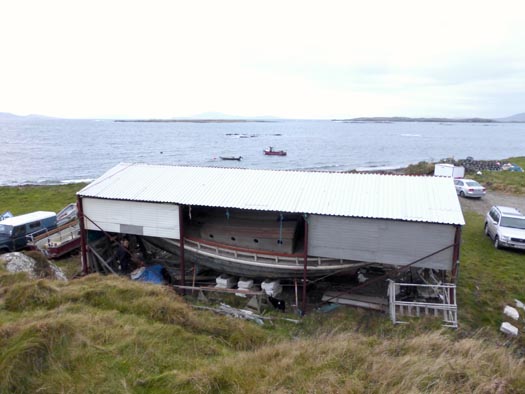
On the Atlantic frontier at Renvyle, the Aigh Vie is under her roof, tilted over to port to facilitate work under the starboard side of the hull. Photo: W M Nixon
For the Aigh Vie is one very special vessel. She's one of the Manx fishing nobbies which reached their ultimate state of development in the first twenty years of the 20th Century before steam power and then diesel engines took over. The nobby evolved to an almost yacht-like form through vessels like the 43ft White Heather (1904), which is owned and sailed under original-style standing lug rig by Mike Clark in the Isle of Man, and the 1910 Vervine Blossom, now based in Kinvara, which was restored by Mick Hunt of Howth, but he gave her a more easily-handled gaff ketch rig which looked very well indeed when she sailed in the Vigo to Dublin Tall Ships Race in 1998.
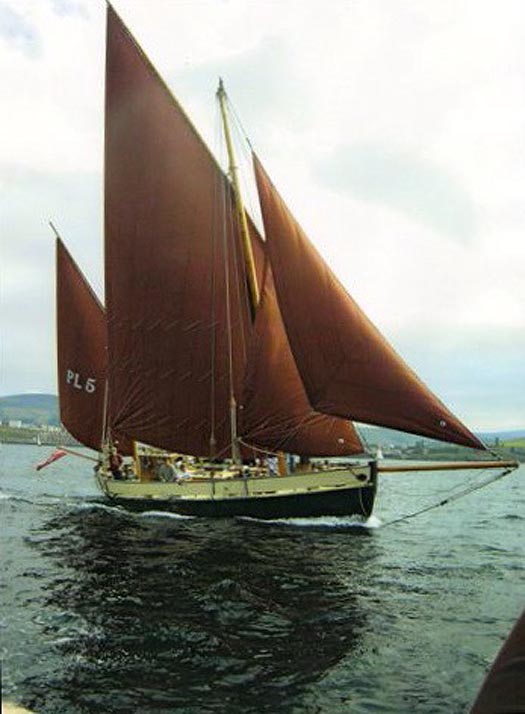
Mike Clark's Isle of Man-based 1904-built Manx nobby White Heather sets the original standing lug rig.
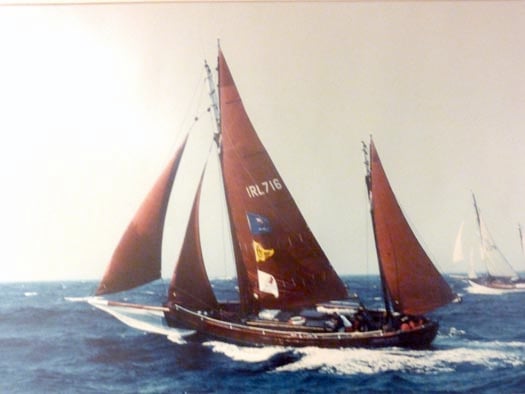
The 1910-built Manx nobby Vervine Blossom was restored by Mick Hunt in Howth, and is seen her making knots under her gaff ketch rig at the start of the 1998 Tall Ships Race from Vigo to Dublin. Photo: David Branigan
It takes quite something to outdo the provenance of these two fine vessels, but the story of Aigh Vie (it means a sort of mix of "good luck" and "fair winds" in Manx) is astonishing. It goes back to the sinking of the Lusitania by a German U Boat off the Cork coast in May 1915, when the first boat to mount a rescue was the Manx fishing ketch Wanderer from Peel, her crew of seven skippered by the 58-year-old William Ball.
They came upon a scene of developing carnage. Yet somehow, the little Wanderer managed to haul aboard and find space for 160 survivors, and provide them with succour and shelter as they made for port. In due course, as the enormity of the incident became clear, the achievement of the Wanderer's crew was to be recognised with a special medal presentation. And then William Ball, who had been an employee of the Wanderer's owner, received word that funds had been lodged with a lawyer in Peel on behalf of one of the American survivors he'd rescued. The money was to be used to underwrite the building of his own fishing boat, to be built in Peel to his personal specifications, and the result was his dreamship, the Aigh Vie, launched in 1916.
Over the years, the Aigh Vie became a much-loved feature of the Irish Sea fishing fleet. Tim Magennis, current President of the Dublin Bay Old Gaffers Association, well remembers her from his boyhood days in the fishing port of Ardglass on the County Down coast. In time, she was bought by the legendary Billy Smyth of Whiterock Boatyard in Strangford Lough, who gradually converted her to a Bermudan-rigged cruising ketch with a sheltering wheelhouse which enabled the Smyth family to make some notable cruises whatever the weather. His son Kenny Smyth, who now runs the boatyard with his brothers and is himself an ace helm in the local 29ft River Class, recalls that the seafaring Smyth family thought nothing of taking the Aigh Vie to the Orkneys at a time when the average Strangford Lough cruiser thought Tobermory the limit of reasonable ambitions.

Aigh Vie as she was when bought by Paddy Murphy from Billy Smyth of Strangford Lough.
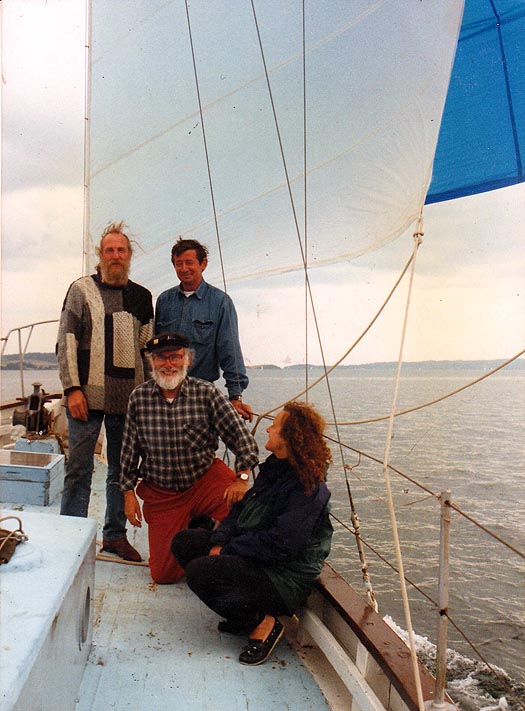
First sail with the newly-bought ship. Aboard Aig Vie heading for Dublin down Strangford Lough, the crew includes Paddy Murphy (left) and Tim Magennis (centre)
It's some years now since Paddy Murphy bought the Aigh Vie, and sailed her back to Dublin with his crew including Tim Magennis. But around the same time, Paddy was moving his base west to Renvyle, where he reckoned his skilled trade as a blacksmith, and his talents in traditional music and folklore, would provide him with a living in the area where he felt most at home.
As for the Aigh Vie, clearly she was reaching an age where work needed to be done. And he was minded to restore her to something more nearly approaching her original 1916 configuration. So somehow or other, he took the big boat west on a truck, managing to negotiate those little winding roads through Tully Cross and down to his place by the sea, where she went under a roof and work began.
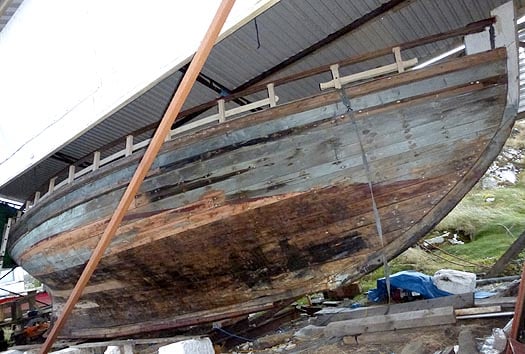
The hull of the 1916-built Aigh Vie as seen in Renvyle shows the remarkably yacht-like lines of the Manx nobby.........Photo: W M Nixon

.........in what was one of the last of the sailing type to be built before steam power took over. Photo: W M Nixon
It has been going on for some time now. The problem with being right on the frontier of Ireland's Atlantic weather is that no sooner do you start on some new area of timber repair and replacement, than the previous restoration section almost immediately starts to become weathered. Working largely on your own, you end up feeling you're going round in circles. So that's why the men from the Naomh Chronan are in Renvyle today to give the Aigh Vie project a mighty push forward.
For there's no doubt that while there's a lot done, there's a lot more still to do. But it does get done eventually if you keep the faith, and I was there back at the beginning of December to cheer Paddy along with all the usefulness of a hurler on the ditch. But at least I was accompanied by Dickie Gomes, who knows a thing or two about long-term boat restoration, as it took him 27 years to bring his 102-year-old Ainmara successfully back to life. But he did it so well that she won the Creek Inn Trophy for "Best in Show" at last summer's Peel Traditional Boat Weekend in the Isle of Man.

A bit of mutual support between two owners of vintage wooden boats – Paddy Murphy and Dickie Gomes in Aigh Vie's shed at Renvyle. Photo: W M Nixon
Nevertheless I've to confess that sometimes I wonder if wood is worth the trouble. Before getting to Renvyle, we'd called by with Jamie Young at Killary Adventure Centre for bit of a love-in with his alloy-built Frers 49 Killary Flyer which - as Brian Buchanan's Hesperia IV - was winner of the Round Ireland Race 1988 under the command of Dickie Gomes. Except that you won't see that fact in histories of the Round Ireland. Because for 1988's race, she sailed as the sponsored entry Woodchester Challenger, and thus was not entitled to the top prize, despite having the best corrected IOR time in the fleet.
But everyone in the know knows that Gomesie won, particularly the crew of Denis Doyle's slightly larger Frers sloop Moonduster. The two boats had been neck and neck running past the Blaskets, and suddenly Hesperia's spinnaker shredded. But Dickie had his crew so well drilled that one half of them had a replacement chute up and drawing before the other half had finished getting in the remains of the torn sail. The boat scarcely missed a beat in her rapid progress, and when the whole business was completed in about three minutes flat, there was a round of applause from Moonduster. You'd sportsmen doing the Round Ireland in those days.
As it happens, one of Hesperia's crew for that neat bit of work was Kenny Smyth, so it made it more than appropriate that we were going on to see the Aigh Vie on which he cut his offshore sailing teeth. But it was good to linger for a while at Jamie's snug place, and marvel at how he, with aid from the ingenious folk of the west, had contrived a slip and an angled trolley so that Killary Flyer can be hauled on site into a sheltered corner, for she's a big lump of a boat to be handling ashore.
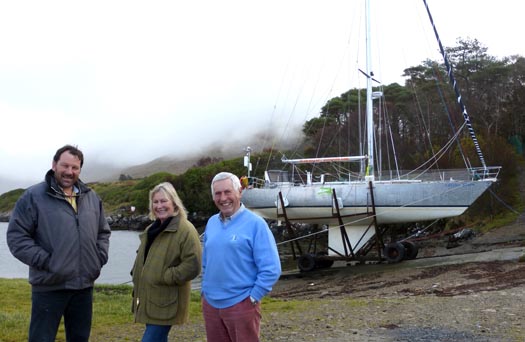
She's a big boat to be hauling on a slip in a remote corner of Mayo. Early December beside Killary Fjord, and Jamie Young of the Adventure Centre with Deirdre and Dickie Gomes and the Frers 49 Killary Flyer ashore for the winter. Deirdre was a fulltime member of the boat's crew when Dickie successfully skippered her offshore as Brian Buchanan's Hesperia IV. Photo: W M Nixon
It was some time in the New Year that we heard the shocking news. One of the most severe storms had twirled the Flyer up like a toy boat from her sheltered corner, and deposited this Frers masterpiece on her ear. Jammed in against the steep shore, she was trapped as the tide came in, and the hull was flooded with severe damage to the electrics and electronics.
But this is the west, where they're accustomed to overcoming massive challenges. The extraordinary Tom Moran of Clew Bay Boats played a key role in a salvage project which saw a temporary road being built so that a giant crane could be positioned for the delicate job of inching the big boat back upright. That done, she could then be moved to Tom's place at Westport for restoration to begin.
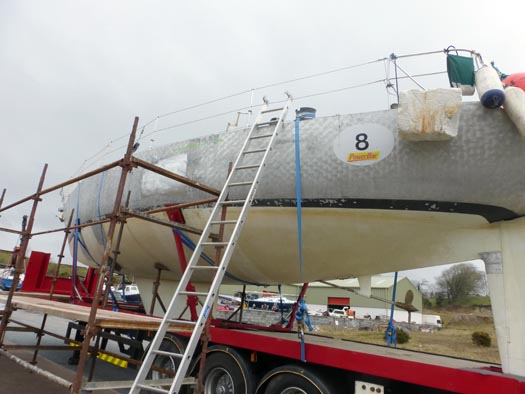
A couple of dents in aluminium? No problem. Following her brief episode of aviation, Killary Flyer's hull is already made good at Clew Bay Boats in Westport. Photo: W M Nixon
The whole business has been a marvellous advertisement for the effectiveness of hull construction using modern marine alloys. When aluminium was first created as the "Metal of the Future" two centuries ago, only the Emperor Napoleon could afford to have a cutlery set made in this exotic stuff. And though an early alloy boat put afloat in Lake Geneva performed reasonably well, as soon as a boat built with it was put into the salty sea, it just melted away.
But over the years the formulas have been adjusted to be corrosion proof in sea water, such that nowadays it's the ideal material for little boats which are going to have hard usage yet little maintenance, such as angling boats and the nippy craft used by rowing coaches.
And if you have a low-maintenance alloy hull yet give it a bit of cosmetic attention, it will look very well indeed, but it's not essential. As for the rough and tumble of life afloat, if you crash into a quay wall with a traditionally built wooden boat, she'll become shook from bow to stern – you never really know where the underlying structural damage ends, if at all. As for GRP and carbon or whatever, the damage will be more localised, but it still gets holed, and messily with it at that, while bulkheads may shift to an unknown degree
But a steel or aluminium hull will generally just be dented, and very locally at that. Repairs are manageable, even if it's skilled specialist work. So there's a lot in favour of steel and alloy. But steel rusts, and it never rusts quicker than in hidden pockets in the structure. But with remarkable advances in alloy welding and building techniques, the advantages of modern corrosion-free alloy construction become more evident every year for boats that are really going to be used, and not just seen as marina ornaments.
The Killary Flyer experience is ultimately a telling argument in favour of alloy construction. The hull was only dented in a couple of places where it was actually in direct contact with outcrops on the foreshore. Any dents have already been repaired by Tom Moran and his team, for they're able for anything to do with boats in any sort of material - I reckon if you wanted to build your dreamship out of resinated peat moss, then Tom would be game for the job.

Can-do people of the west – Mary and Tom Moran of Clew Bay Boats have successfully taken on many marine problems and projects. Photo: W M Nixon
Sorting out the interior systems is going to be more of a challenge, for Hesperia was originally Noryema X, built for Ron Amey in 1975. In a sense, there's a feeling of homecoming in the fact that she's being restored in Westport. If you head directly inland from that lovely little town, you're soon up in the mountains in the Joyce Country. And way back in 1975, the alloy hull of Noryema X was built by the renowned Joyce Brothers. Their fabrication workshop may have been in Southampton, but the family wasn't that long out of the mountains of far Mayo.
However, once the innovative Ron Amey had taken delivery of the hull of his latest Noryema from the brothers Joyce, he then took it to Moody's big shed at Bursledon on the Hamble for completion by the boatyard's craftsmen. I happened to be Bursledon-based in the early summer of 1975, and it really was all a wonder to behold.
Amey had installed a caravan in Moody's shed, and he lived in it while overseeing every detail of the new boat's fitout, while at the same time running his business empire of Amey Roadstone from a telephone in the caravan. It was said that the great man wouldn't be really happy with his new boats until the final jobs were completed just before the Fastnet Race in August, and after that he'd then start to think of the next one. But Noryema X was something special. She became the last of the racing line, and despite her enormous rig, Ron Amey then used her for eleven years of cruising in the Mediterranean which concluded with her sale to Brian Buchanan of Belfast Lough at Marseilles in 1986. She has been based on our island ever since, the source of much seagoing pleasure for hundreds of Irish sailors.
So bringing her back up to Amey standards is quite a challenge, as she's now part of Ireland's sailing heritage. But with Tom Moran they've someone who seems to have links with every maritime specialist in the country, and if he draws a blank in Ireland, his connections around the Solent marine industry seem pretty hot too.

Not quite where you'd expect to find an Arctic voyaging vessel, but Northabout seems at home in the Moylure Canal in the midst off Mayo fields. Photo: W M Nixon
Much encouraged by all this, for Clew Bay Boats is the sort of place where many good things seem possible, we then headed down to the Moylure Canal, a drainage waterway near Rosmoney at the head of Clew Bay where the great Jarlath Cunnane has created a tiny boat harbour and beside it a little place where, if so minded, he can build himself a boat.
Jarlath is the quintessential Connacht mariner, yet you'll never find him being sentimental about wooden boats. On the contrary, in the time I've known him he has built himself a steel van de Stadt 34ft sloop which he cruised very extensively, and more recently he took on the challenge of alloy construction to build the 44ft Northabout. Aboard this special boat, in teamwork with Paddy Barry, he has made cruises to remote and challenging places in voyages which, for most people, would have required full military logistical support.
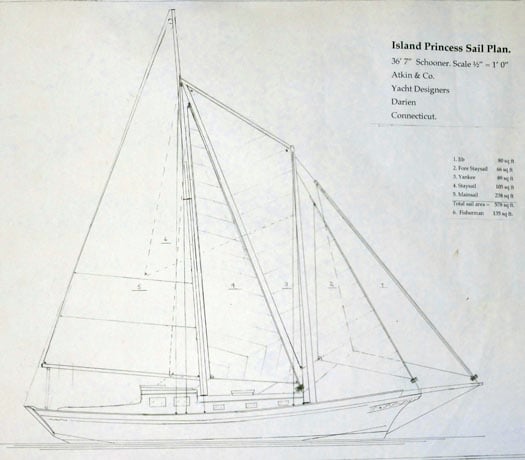
The new dreamship. Plans of the 37ft Atkins schooner which Jarlath Cunnane has been building over four years.
Knowing the scale of what he has done with her, it was bizarre to see Northabout sitting modestly in her berth in the little creek beside a Mayo field. But the presence of the long distance high latitude voyager was only part of the Moylure package. A few feet away in "the shed which isn't really a shed" was the new Cunnane boat, a sweet 37ft–Atkins schooner which, if you haven't yet appreciated the potential of good alloy boat construction, would surely win you over in a trice.

Good alloy construction, as seen here in the stemhead of the new schooner, can withstand comparison with any material. Photo: W M Nixon
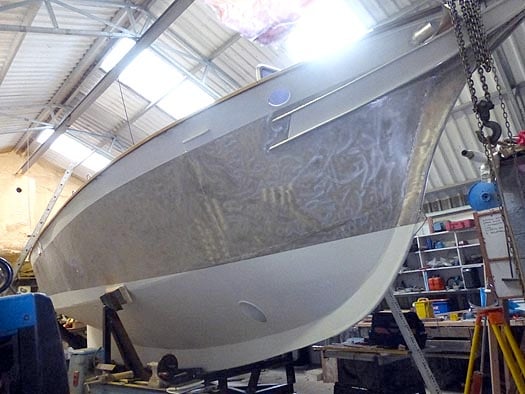
The new schooner has a workmanlike and handsome hull......Photo: W M Nixon

....which is aimed for comfort as much as speed, but she should be able to give a good account of herself in performance, and will be very comfortable for longterm periods on board. Photo: W M Nixon
Jarlath has taken four years on the construction, and when he gets to sailing the new boat, I'd say that the motto will be: "When God made time, he made a lot of it". This is a boat for leisurely cruising, a boat to enjoy simply being on board. In her finished state, she'll give little enough in the way of clues as to her basic construction material. Like Killary Flyer, and like Northabout too, she is in her own way a great advertisement for the potential of good alloy construction.
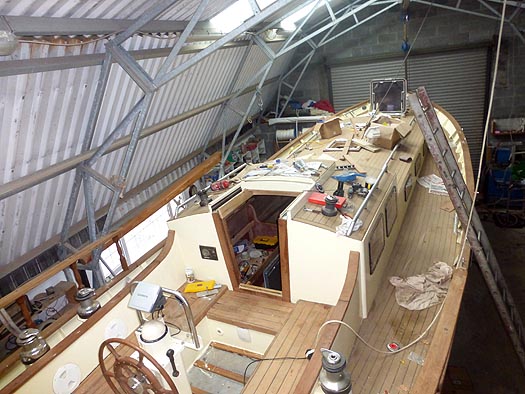
As completion nears, it becomes ever less apparent......Photo: W M Nixon
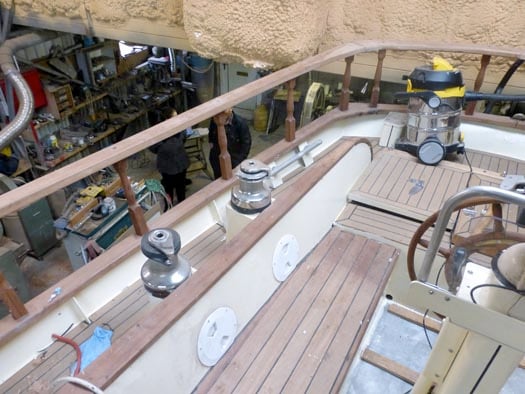
.....that the hull construction of the new schoner is in aluminium. Photo: W M Nixon
So we'll sign off this week with a special thought. As Irish life begins to move again, doubtless we'll soon hear increasing mutterings about the desirability of building a new Asgard sail training brigantine. Maybe we should keep the government out of it this time round, and build her through a voluntary trust organisation supported by public subscriptions and corporate donations. But however it's to be done, we should be starting to think about it.
And like many others, I've long thought that the ideal way forward would be with a steel hull built to Jack Tyrell's original Asgard II lines, which have a magnificently timeless quality to them. But I've changed my mind on that. Having seen what can be done with good alloy construction down in Mayo, and knowing the quality of alloy workboat construction being produced by firms like Mevagh Boatyard in Donegal and by the descendants of Jack Tyrrell among others at Arklow Marine Services in County Wicklow, it's difficult to escape the conclusion that the hull of the new ship should be built in aluminium.
It would be initially expensive, but it would confer great longterm maintenance advantages. And by going that way, we'd be able to provide all the double skins and safety bulkheads which will now be required without using up all available hull space, and without producing a boat so heavy she wouldn't be able to sail out of her own way. So let's hear it for an aluminium-hulled Asgard III.



























